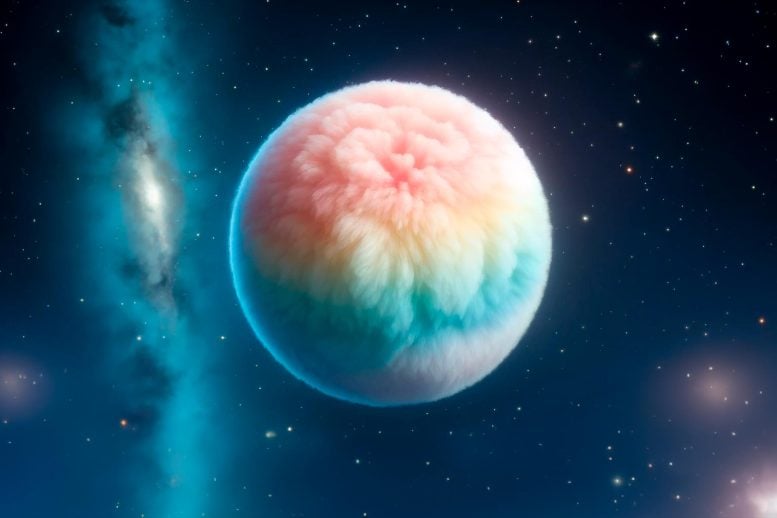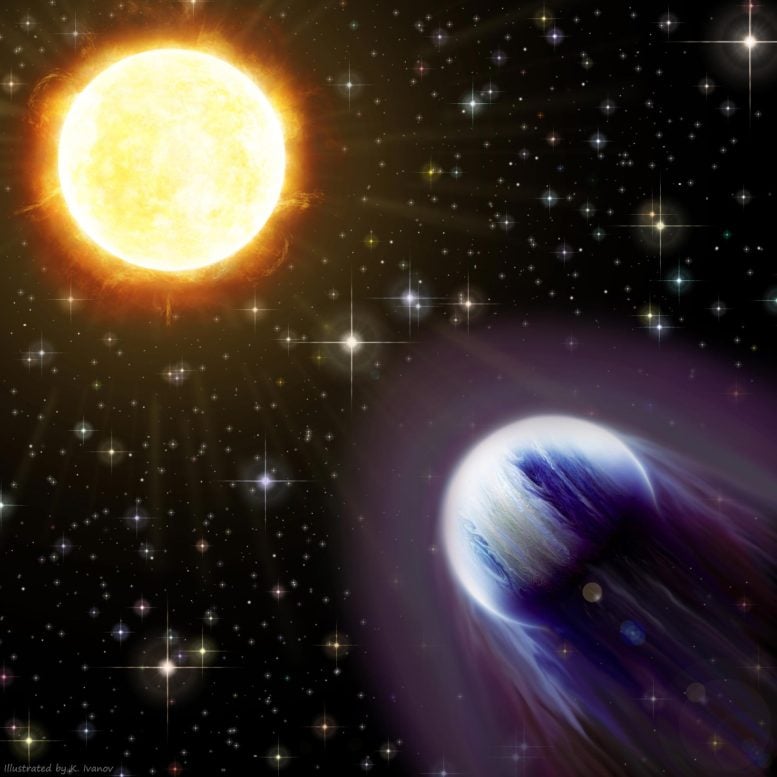
Astronomers have discovered a massive, low-density planet named WASP-193b that is 50% larger than Jupiter but has the same density as cotton candy. The discovery challenges existing theories of planet formation. (Artist’s concept.) Credit: SciTechDaily.com
Astronomers have discovered a massive, low-density planet named WASP-193b that is 50% larger. Thursday But it is dense like cotton candy. The discovery challenges current theories of planet formation, as scientists cannot explain how such a planet would form.
Astronomers have discovered a giant fluffy oddball of a planet orbiting a distant star. milky way Galaxy. The discovery was reported in the journal May 14 Natural Astronomy By researchers from withAt the University of Liège in Belgium and elsewhere, it holds a promising key to the mystery of how such giant, super-light planets form.
The new planet, named WASP-193b, appears dwarfed by Jupiter’s size, although it is a fraction of its density. Scientists estimate that the gas giant is 50 percent larger than Jupiter and one-tenth as dense — the lowest density, comparable to cotton candy.
WASP-193b is the second lightest planet discovered to date, after the smallest planet. Neptune– Like the world, Kepler 51D. The new planet’s sheer size, combined with its super-light density, makes WASP-193b the oddest of the more than 5,400 planets discovered to date.
“Finding these giant objects with such small densities is extremely rare,” says lead study author and MIT postdoc Khalid Barghoui. “There is a class of planets called buffy Jupiters, and what they are has been a mystery for 15 years now. This is an extreme case of that class.
“We don’t know where to place this planet among all the formation theories we have now, because it’s outside of all of them,” says co-lead author Francisco Pozuelos, a senior researcher at the Astrophysical Institute of Andalusia. In Spain. “We cannot explain how this planet formed based on classical evolutionary models. Looking more closely at its atmosphere will allow us to derive the planet’s evolutionary path.
The study’s MIT co-authors include Julian de Wit, assistant professor in MIT’s Department of Earth, Atmospheric and Planetary Sciences, and MIT postdoc Artem Burdanov, along with collaborators from several institutions across Europe.

Artist’s impression of the WASP-193b system. Credit: University of Liège
“An Interesting Twist”
The new planet was initially discovered by the Wide Angle Search for Planets, or WASP – an international collaboration of academic institutions that operates two robotic observatories together, one in the northern hemisphere and the other in the southern. Each observatory uses an array of wide-angle cameras to measure the brightness of thousands of individual stars across the entire sky.
In surveys taken between 2006 and 2008, and again in 2011 to 2012, the WASP-South Observatory detected periodic bursts, or dips, in light from WASP-193, a bright, nearby, Sun-like star located 1,232 light-years from Earth. Astronomers determined that the star’s brightness decreases over time, with a planet orbiting the star every 6.25 days and blocking its light. The scientists measured the total amount of light blocked at each transit of the planet, giving an estimate of the planet’s giant, super-Jupiter size.
Astronomers then tried to deduce the planet’s mass – which would reveal its density and provide clues to its composition. To get a mass estimate, astronomers typically use radial velocity, a technique in which scientists analyze a star’s spectrum, or different wavelengths of light, as a planet orbits the star. A star’s spectrum can be altered in specific ways depending on what is pulling on the star, such as an orbiting planet. The more massive a planet is, and the closer it is to its star, the more its spectrum can shift – giving scientists an idea of a planet’s mass.
For WASP-193 b, astronomers obtained additional high-resolution spectra of the star taken by various ground-based telescopes and tried to use the radial velocity to calculate the planet’s mass. But they kept coming up empty—precisely, as it turned out, the planet was so light it had no detectable tug on its star.
“In general, it’s easier to detect massive planets because they’re usually massive, and lead to a big drag on their star,” De Wit explains. “But the tricky thing about this planet is that even though it’s big — even big — its mass and density are so low that it was really hard to detect with the radial velocity technique. It was an interesting twist.
“[WASP-193b] It’s so light, it took four years to collect the data and show that there is a mass signal, but it’s actually very small,” says Barghoui.
“We got a very low density at the beginning, which was very hard to believe at the beginning,” Pozuelos adds. “This is very rare because we repeated all the data analysis process several times to make sure this is the true density of the planet.”
An inflatable world
Ultimately, the team confirmed that the planet was very light. They calculated its mass to be 0.14 that of Jupiter. Its density, derived from its mass, came to about 0.059 grams per cubic centimeter. Jupiter, by contrast, is about 1.33 grams per cubic centimeter; And Earth is heavier at 5.51 grams per cubic centimeter. Cotton candy, with a density of about 0.05 grams per cubic centimeter, is the closest material in density to a new, bloated planet.
“The planet is so light that it’s hard to think of a homogeneous, solid-state object,” says Barghoui. “The reason it’s closer to cotton candy is that both are mostly composed of light gases rather than solids. The planet is basically very fluffy.
Like other gas giants in the galaxy, researchers suspect that the new planet is composed mostly of hydrogen and helium. In the case of WASP-193b, these gases could form a large windy atmosphere that extends tens of thousands of kilometers beyond Jupiter’s own atmosphere. How far a planet can accret while maintaining a super-light density is a question that no existing theory of planet formation can yet answer.
To get a better picture of the new spongy world, the team plans to use the previously developed de Wit technique to first obtain some properties of the planet’s atmosphere, such as its temperature, composition and pressure at various depths. These characteristics can be used to accurately calculate the planet’s mass. For now, the team sees observatories like WASP-193b as a good candidate for a follow-up study. The James Webb Space Telescope.
“The bigger a planet’s atmosphere, the more light can get through,” De Wit says. “So it’s clear that this planet is one of the best targets for studying atmospheric effects. It can be a Rosetta stone for trying to solve the mystery of bloated Jupiter.
Reference: “An extended low-density atmosphere around the Jupiter-sized planet WASP-193 b” Khaled Bargouy, Francisco J. Posuelos, Goel Hellyer, Barry Smalley, Louis D. Nielsen, Brajval Niravla, Michael Gillen, Julian de Wit, Simon Muller, Caroline Dorn, Ravit Held, Emmanuel Zehin, Bryce-Oliver Demory, Valerie van Grudel, Abderrahmane Soubkio, Mourad Kachoi, David. R. Andersen, Zuhair Benkaltoun, Francois Bouchy, Artem Burdanov, Letitia Delres, Elsa Ducrot, Lionel Garcia, Abdelhadi Jabri, Monica Lendel, Pierre FL Maxtedt, Catriona A. Murray, Peter Bihlman Pederston, Dearly Kuelbachen, Dearly, Dearly, Stephen Woodry, Mathilde Timmermans, Amuri HMJ Dryad, and Richard G. West, May 14, Natural Astronomy.
DOI: 10.1038/s41550-024-02259-y
This research was funded, in part, by the UK’s Science and Technology Facilities Council for Commonwealth Universities and WASP; European Research Council; Wallonia-Brussels Confederation; and the Heising-Simons Foundation, Colin and Leslie Masson, and Peter A. Gilman, who support Artemis and other SPECULOOS telescopes.